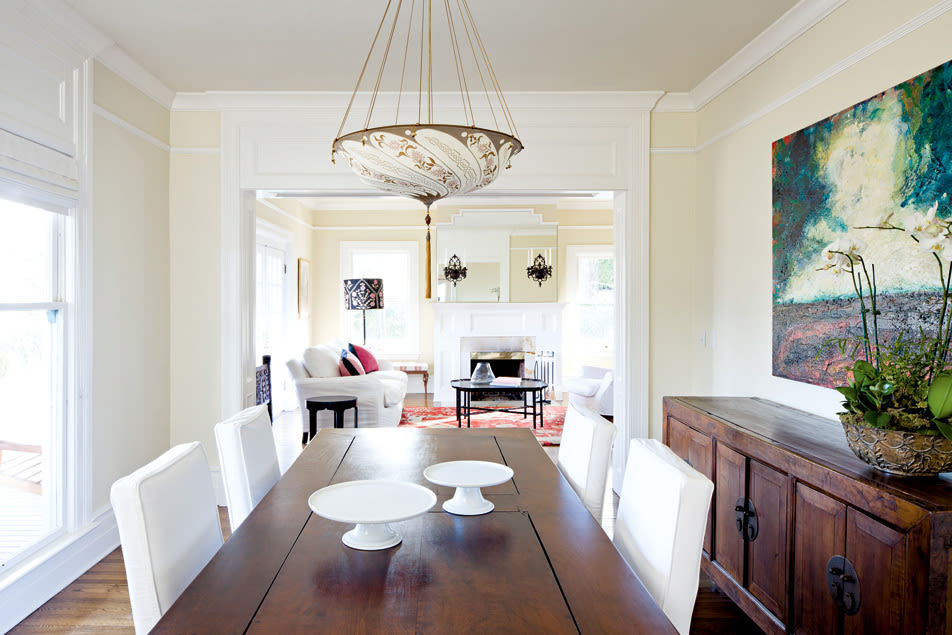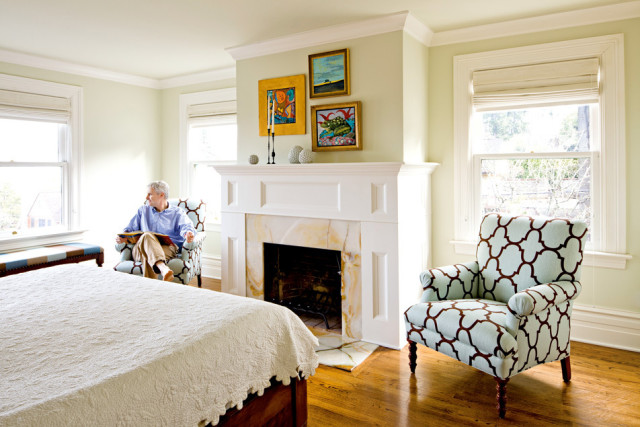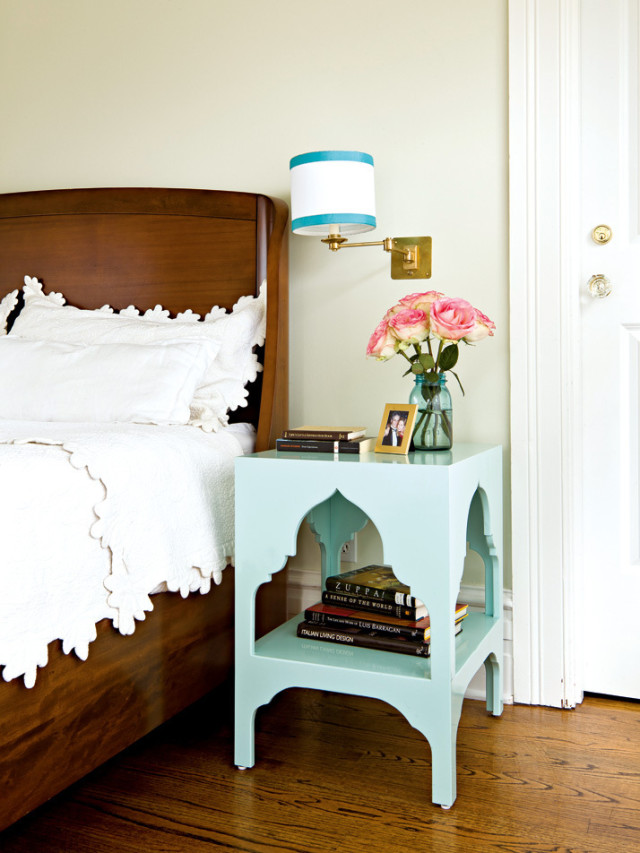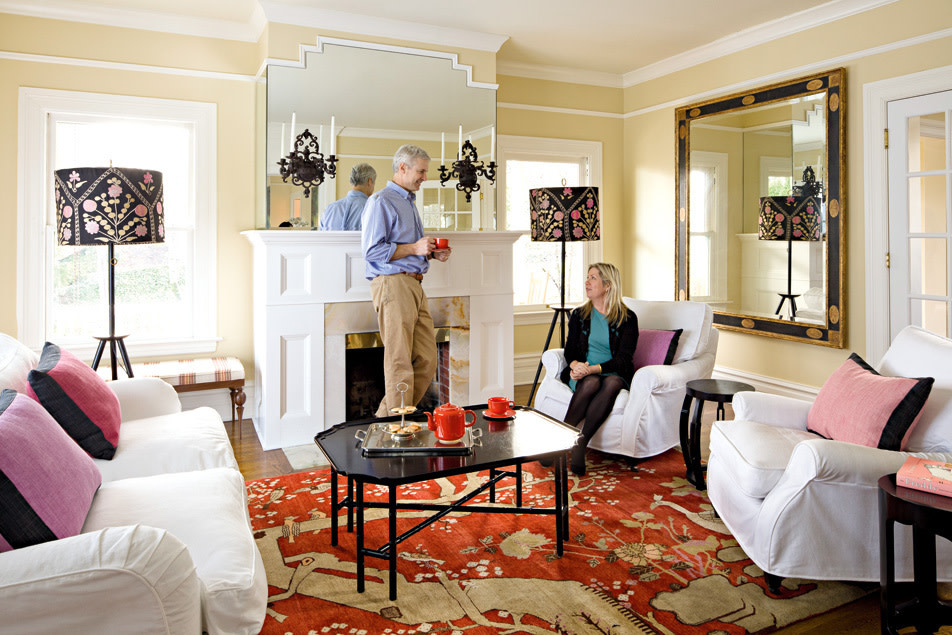Here Comes The Sun

Image: Lincoln Barbour
ON A FROSTY WINTER MORNING, as the wind whips around shivering trees in the West Hills, Jessica Spies and Martin Sommer’s home beckons like a beacon of light. The graceful, century-old Victorian with a farmhouse mien has a wraparound porch that invites guests up the steps and through the front door. Inside, the fireplace crackles, Legos are scattered underfoot, and aromas of beef bourguignonne waft through the air. “I wanted the house to feel like sunshine,” Spies says.

The master suite is a calm retreat in serene blues. In the bedroom, a Restoration Hardware bed is flanked by side tables made by local artisan Kai Fuhrmann.
Spies, a busy dermatopathologist, and Sommer, a software engineer, followed their jobs to Portland from Albuquerque, New Mexico, in 2007 with their young son, Max. Lamenting the absence of desert light and clear skies, they were determined to find a bright, airy house to compensate for the gray outside. They fell in love with their home’s large rooms, plentiful windows, and ample 3,700 square feet, as well as its location in the storied Ainsworth grid. It was an added perk that the house had already been extensively remodeled by two previous sets of owners, who had added trim, overhauled the kitchen, and knocked down walls. All that remained, then, was to put their own personal stamp on the place with décor—for assistance, they turned to local firm Jessica Helgerson Interior Design.
Often, when a designer is called in to decorate, the designer’s style ends up filling the space. In this case, Helgerson was stonewalled. Spies, a vivacious blonde and self-professed fashion maven known by first name at Mario’s, had a clear vision of a comfortably elegant space tinged with Hollywood glamour—she just didn’t know how to achieve the look on her own. “She has a strong point of view,” says designer Andy Beers, who worked on the project at Helgerson’s office before co-founding his own firm, Ore Studios. “She just needed a filter and someone to tell her which pieces to add to make it cohesive.”

In the beginning, Helgerson remembers, the house was empty but for “a sofa, two chairs, and a lot of boxes,” all set against a backdrop of dark mustard and green walls. Helgerson—who favors cool grays and an understated palette—found Spies’s “feminine, fancy aesthetic” startling, with its warm whites punctuated by vivid splashes of color. But the personalities clicked, and the designers slipped into roles of facilitators to their client’s overall vision.
Spies’s love of color pops up throughout the house. A pale goldenrod fills the living room walls and shines one shade lighter in the dining room, and a range of hues emerge as pillows in the family room, softening the hard lines of the black leather couch. In the living room, oversize pink pillows rimmed with black rest on the slipcovered Brenda Antin couch and chairs. After seeing a Chinese Khotan rug in Madison Millinger’s showroom that they liked but for its muted shades, Spies and Sommer opted to custom-order a version in which the browns became cream-colored. They had lampshades made from intricate, 60-year old Turkistani fabrics from the Portland store Cargo. Upstairs in the master bedroom, side tables made by local designer Kai Fuhrmann are lacquered in Tiffany blue, echoed in the delicate geometric light blue and brown print of the chairs nearby.

In the dining room, a large Mexican dining table and Crate & Barrel chairs are lit from above by a classic Fortuny pendant.
Image: Lincoln Barbour
Lest the spaces seem disjointed, the frills and flounces of the living room and bedroom and the muted masculinity of the family room are tied together with Middle Eastern flourishes, from the textiles and lampshades to the tribal rugs and Moroccan poufs. Mirrors refract light throughout the house, providing additional continuity: a six-foot-tall mirror in the living room, elegantly appointed with a Katayama handcrafted frame, reflects a view to the trees outside, while a ginkgo-blossom mirror expands the upstairs bathroom. The trim, initially a dark cherry color in the family room but now painted white, completes the bridge between the family room, living room, and dining room.

“I don’t think a house can have enough mirrors,” says Spies. In the living room, oversize mirrors bounce beams from the various lamps throughout the house.
The result is a home that’s both striking and livable, evidenced in the dog-eared kids’ books scattered on tabletops, pillows thrown on the floor for lounging and impromptu napping, and the whole family sprawling on the sectional couch to watch movies.
“I grew up with a living room we couldn’t sit in, play in, or eat in, and it never got used,” says Spies, stepping around a Playmobil truck in the middle of the floor. “Here, everything has a function and we enjoy the spaces, yet it’s all beautiful. I look forward to coming home.”




